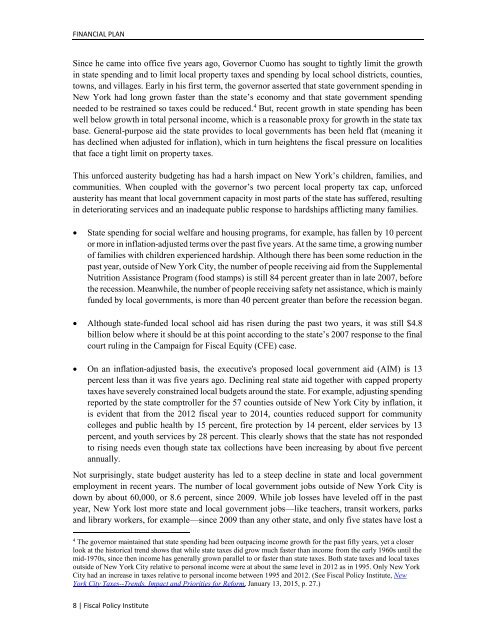2016-2017
1PSJ98W
1PSJ98W
Create successful ePaper yourself
Turn your PDF publications into a flip-book with our unique Google optimized e-Paper software.
FINANCIAL PLAN<br />
Since he came into office five years ago, Governor Cuomo has sought to tightly limit the growth<br />
in state spending and to limit local property taxes and spending by local school districts, counties,<br />
towns, and villages. Early in his first term, the governor asserted that state government spending in<br />
New York had long grown faster than the state’s economy and that state government spending<br />
needed to be restrained so taxes could be reduced. 4 But, recent growth in state spending has been<br />
well below growth in total personal income, which is a reasonable proxy for growth in the state tax<br />
base. General-purpose aid the state provides to local governments has been held flat (meaning it<br />
has declined when adjusted for inflation), which in turn heightens the fiscal pressure on localities<br />
that face a tight limit on property taxes.<br />
This unforced austerity budgeting has had a harsh impact on New York’s children, families, and<br />
communities. When coupled with the governor’s two percent local property tax cap, unforced<br />
austerity has meant that local government capacity in most parts of the state has suffered, resulting<br />
in deteriorating services and an inadequate public response to hardships afflicting many families.<br />
• State spending for social welfare and housing programs, for example, has fallen by 10 percent<br />
or more in inflation-adjusted terms over the past five years. At the same time, a growing number<br />
of families with children experienced hardship. Although there has been some reduction in the<br />
past year, outside of New York City, the number of people receiving aid from the Supplemental<br />
Nutrition Assistance Program (food stamps) is still 84 percent greater than in late 2007, before<br />
the recession. Meanwhile, the number of people receiving safety net assistance, which is mainly<br />
funded by local governments, is more than 40 percent greater than before the recession began.<br />
• Although state-funded local school aid has risen during the past two years, it was still $4.8<br />
billion below where it should be at this point according to the state’s 2007 response to the final<br />
court ruling in the Campaign for Fiscal Equity (CFE) case.<br />
• On an inflation-adjusted basis, the executive's proposed local government aid (AIM) is 13<br />
percent less than it was five years ago. Declining real state aid together with capped property<br />
taxes have severely constrained local budgets around the state. For example, adjusting spending<br />
reported by the state comptroller for the 57 counties outside of New York City by inflation, it<br />
is evident that from the 2012 fiscal year to 2014, counties reduced support for community<br />
colleges and public health by 15 percent, fire protection by 14 percent, elder services by 13<br />
percent, and youth services by 28 percent. This clearly shows that the state has not responded<br />
to rising needs even though state tax collections have been increasing by about five percent<br />
annually.<br />
Not surprisingly, state budget austerity has led to a steep decline in state and local government<br />
employment in recent years. The number of local government jobs outside of New York City is<br />
down by about 60,000, or 8.6 percent, since 2009. While job losses have leveled off in the past<br />
year, New York lost more state and local government jobs—like teachers, transit workers, parks<br />
and library workers, for example—since 2009 than any other state, and only five states have lost a<br />
4<br />
The governor maintained that state spending had been outpacing income growth for the past fifty years, yet a closer<br />
look at the historical trend shows that while state taxes did grow much faster than income from the early 1960s until the<br />
mid-1970s, since then income has generally grown parallel to or faster than state taxes. Both state taxes and local taxes<br />
outside of New York City relative to personal income were at about the same level in 2012 as in 1995. Only New York<br />
City had an increase in taxes relative to personal income between 1995 and 2012. (See Fiscal Policy Institute, New<br />
York City Taxes--Trends, Impact and Priorities for Reform, January 13, 2015, p. 27.)<br />
8 | Fiscal Policy Institute


